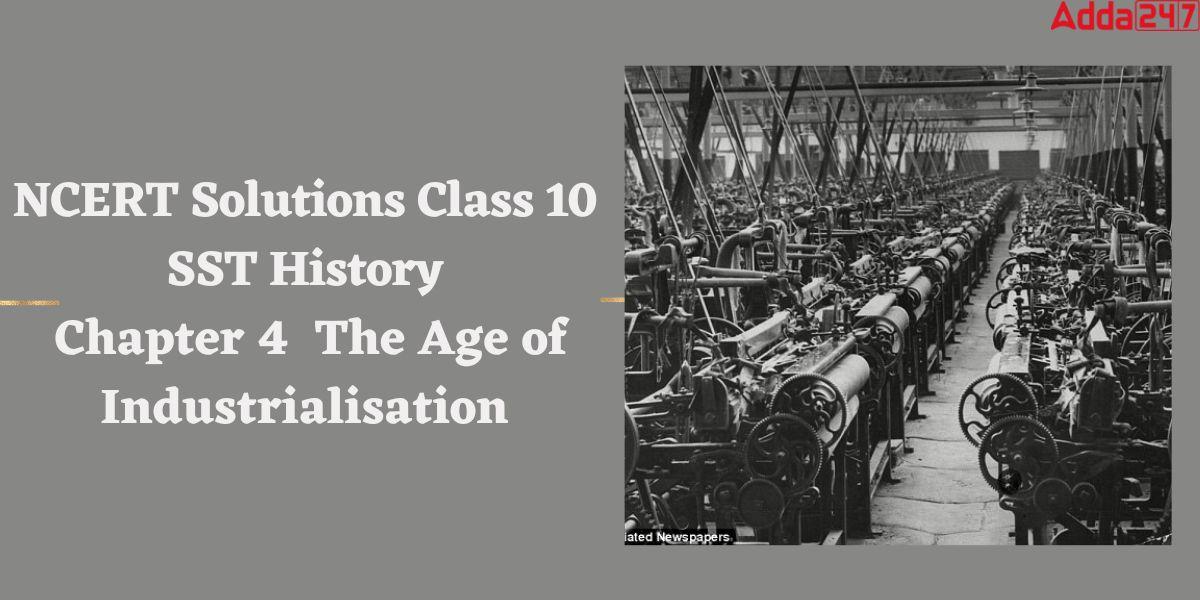Table of Contents
NCERT Solutions Class 10 SST History Chapter 4 The Age of Industrialisation Notes
NCERT Solutions Class 10 SST History Chapter 4 The Age of Industrialisation notes are given in this article. NCERT Solutions Class 10 is the best resource for obtaining a good score in the class 10 board Examination. Here are Adda247 Expert faculty team prepared NCERT Solutions Class 10 SST History Chapter 4 The Age of Industrialisation exercises of that chapter for a better grasp of the topics. These NCERT Solutions answer all questions in an easy and simple manner. These solutions will help you understand the concepts covered in the chapter completely. By writing these answers in the exam students will undoubtedly be able to achieve high scores. Keep learning with Adda247.
NCERT Solutions for Class 10 SST History Chapter 4 The Age of Industrialisation Pdf Download
NCERT Solutions Class 10 SST History Chapter 3 The Making of a Global World pdf is given in pdf format so students can easily download it for future use. Click here to download NCERT Solutions Class 10 SST History Chapter 4 The Age of Industrialisation
NCERT Solutions Class 10 SST History Chapter 3 The Making of a Global World Explanation
NCERT Solutions Class 10 SST History Chapter 3 The Making of a Global World Summary
NCERT Solutions Class 10 SST History Chapter 4 The Age of Industrialisation introduces the European Industrial Revolution. In combination with industrialization, students will know about the history of Britain, How industries are modernization factories, and How Britain became the first industrialised country, followed by India, resulting in the mass production of products and global trade. Let’s take a quick tour of the topics and subtopics associated with NCERT Solutions Class 10 SST History Chapter 4 The Age of Industrialisation:
- Before the Industrial Revolution
- The Coming Up of the Factory 1.2 The Pace of Industrial Change
- Hand Labour and Steam Power
- Life of the Workers
- Industrialisation in the Colonies
- The Age of Indian Textiles 3.2 What Happened to Weavers? 3.3 Manchester Comes to India
- Factories Come Up
- Early Entrepreneurs 4.2 Where Did the Workers Come From?
- The Peculiarities of Industrial Growth
- Small-scale Industrial Predominate
- Market for Goods
NCERT Solutions Class 10 SST History Chapter 4 The Age of Industrialisation Question with Answer
1. Explain the following:
a) Women workers in Britain attacked the Spinning Jenny.
b) In the seventeenth-century merchants from towns in Europe began employing peasants and artisans within the villages.
c) The port of Surat declined by the end of the eighteenth century.
d) The East India Company appointed Gomasthas to supervise weavers in India.
Answer:
- British women labourers rejected the Spinning Jenny because it accelerated the spinning process and reduced the need for labour. With the Spinning Jenny, a single worker could simultaneously spin multiple threads and set a number of spindles in motion with the turn of a single wheel. Women employed in the woollen sector had a genuine fear of losing their jobs as a result of the new machine.
- In the seventeenth century merchants from towns in Europe began employing peasants and artisans within the villages because, with the growth of global trade, there was an increase in demand for goods. The rise in demand was partly caused by the purchase of colonies. Town producers were unable to increase production because of the influence of urban trade guilds, which prevented them from producing the required amount. These producer groups imposed restrictions on newcomers’ ability to enter the market. Different guilds were given exclusive rights to produce and trade in certain goods by the monarchs. Therefore, it was challenging for new merchants to establish themselves in towns. As a result, they looked to the countryside and started hiring farmers and craftspeople in the villages.
- Before the introduction of machine industries, India controlled the global textile market with its silk and cotton products. But later, by obtaining a number of concessions from the regional courts as well as the authority to trade monopolistically, European corporations progressively increased their influence in trade with India.
Bombay and Calcutta expanded while Hoogly and Surat declined because trade was now routed through the new ports and carried by European ships. Exports from these ports suddenly fell, and by the end of the eighteenth century, the port of Surat was in decline. - In order to have greater direct control over the weavers, the business attempted to eliminate the existing merchants and brokers connected to the textile trade. It assigned Gomastha, a salaried servant, to oversee weavers, gather materials, and assess the fabric’s quality. Utilize advances and control to keep weavers from engaging with other purchasers. In this way, weavers who accepted loans and fees in advance owed the British money.
2. Write True or False against each statement:
a) At the end of the nineteenth century, 80 per cent of the total workforce in Europe was employed in the technologically advanced industrial sector.
b) The international market for fine textiles was dominated by India till the eighteenth century.
c) The American Civil War resulted in the reduction of cotton exports from India.
d) The introduction of the fly shuttle enabled handloom workers to improve their productivity.
Answer:
- False
- True
- False
- True
3. Explain what is meant by proto-industrialisation.
Answer: There was a significant industrial output on a wide scale for a global market even before factories started to appear on the landscape of England and Europe. These days, a lot of historians term this stage of industrialization “proto-industrialization” or “the antecedent of industrialization.” The regional development of rural handicraft production for international markets, combined with commercial agriculture, is known as proto-industrialization. This kind of industrialization was built on decentralised units rather than the factory structure.
4. Why did some industrialists in nineteenth-century Europe prefer hand labour over machines?
Some British businesses chose manual labour over machines in the 19th century in Europe because
- The cost of and lack of testing for new technology and equipment. Thus, they were used with caution by producers and industrialists.
- Since there were more employees available than there were jobs available, labour was accessible at low wages as poor peasants and migrants migrated to cities in large numbers in quest of employment.
- Machines were expensive, and they were even more expensive to repair.
- Machine-produced apparel was unable to satisfy consumer demands for a wide variety of styles, colours, and types. Only human abilities could produce complex patterns and colours.
5. How did the East India Company procure regular supplies of cotton and silk textiles from Indian weavers?
Answer: To ensure regular supplies of cotton and silk fabrics, the East India Company took a number of measures-
- To impose more direct control on the weavers, the already-existing merchants and brokers were eliminated.
- Through a system of advances and loans, the company weavers were kept away from other purchasers. The weavers received loans to pay for the raw materials needed for their manufacture when an order was placed
- The designation of compensated supervisors is referred to as a gomastha. They also acquired materials and assessed the fabric quality produced by the weavers.
- To claim exclusive control over the right to trade, they built political power.It reduces competition, regulate costs, and guarantees a consistent supply of cotton and silk products
6. Imagine that you have been asked to write an article for an encyclopaedia on Britain and the history of cotton. Write your piece using information from the entire chapter.
Describe your response in your own words. You might find the following key points while answering:
- In the 17th and 18th centuries, traders engaged in textile production trade with rural populations.
- During the initial stage, the clothier would purchase the wool from a stapler, transport it to the spinners, and then deliver the spun yarn to the weavers. It was then delivered to the fullers and dyers for additional production stages.The centre for finishing these goods was London.
- Proto-industrialization is the term used to describe this period in British manufacturing history. During this time, factories weren’t a crucial component of industry.
- The earliest factory era emblem was made of cotton. In the latter half of the nineteenth century, production rose quickly.
- The amount of raw cotton imported increased from 2.5 million pounds in 1760 to 22 million pounds in 1787 as a result of the development of the cotton mill, new equipment, and improved management.
- Cotton was the dominant industry in the early stages of industrialization until 1840.
- The majority of textile industry inventions contributed to unemployment. Because it was displacing them on the labour market, women in the woollen industry were hostile to it and asked that it be destroyed.
- Before such technological advancements, Britain imported large quantities of cotton and silk products from India.
- After gaining control of the nation’s politics, the East India Company abused the country’s weavers and textile industry.
- Later, Manchester was transformed into the centre of the cotton industry, and India became the main market for British cotton products.
- British factories were very busy producing the necessary items for the First World War. Again, as a result, there was a great demand for Indian textiles. Thus, these shifts in supply and demand have shaped cotton’s history in
7. Why did industrial production in India increase during the First World War?
India’s industrial output increased during World War for the following reasons:
- The military necessities were produced and supplied by British industries, which became very active. As a result, they stopped exporting British products and clothing for territories like India.
- The sudden drop in imports provided an excellent opportunity for Indian companies to increase production and meet domestic market demand.
- The development of new factories and the expansion of the existing ones were encouraged by the growing demand for a larger variety of goods.
- Manchester was never able to regain its previous position in the Indian market after the war. After the war, Britain’s economy collapsed because it was unable to modernise and compete with the US, Germany, and Japan.
For these reasons, British exports of cotton textiles declined drastically as well as cotton production. Therefore, the First World War helped India’s industry.
Found this article helpful?
Let’s connect via chat or call our senior expert counselor at +91-9625869989 to learn more about the different streams and options available. We would love it if we could add some of your insights. If you have a definite goal of scoring the highest marks, then you can resolve your doubts via our app and youtube class assistance (https://www.youtube.com/c/Adda247School)



 NEET City Intimation Slip 2025 Available...
NEET City Intimation Slip 2025 Available...
 CUET UG Date Sheet 2025 @cuet.nta.nic.in...
CUET UG Date Sheet 2025 @cuet.nta.nic.in...
 WBCHSE HS Result 2025 Date OUT, West Ben...
WBCHSE HS Result 2025 Date OUT, West Ben...










